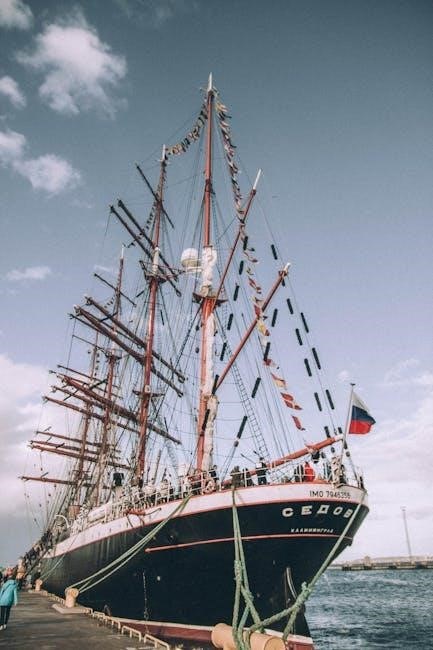
The Russian Navy, established in 1696, plays a pivotal role in national defense and geopolitical influence, with a rich history and modern capabilities shaping global maritime security.
1.1. Overview of the Russian Navy
The Russian Navy is a key component of the nation’s military, responsible for protecting territorial waters, ensuring maritime security, and projecting power globally. It operates under the Russian Armed Forces, with a command structure led by the Commander-in-Chief. The Navy is divided into four main fleets (Pacific, Northern, Baltic, and Black Sea) and the Caspian Flotilla, each specializing in regional defense and strategic missions. Its fleet includes submarines, aircraft carriers, destroyers, and smaller surface vessels, supported by naval aviation and coastal defense systems. The Navy plays a critical role in Russia’s strategic nuclear deterrence and is undergoing modernization to enhance its capabilities and readiness.
1.2. Importance of Naval Fleets in Russian Defense Strategy
Russia’s naval fleets are integral to its defense strategy, ensuring national security, safeguarding maritime borders, and maintaining strategic deterrence. The Navy’s ability to project power across the world’s oceans supports Russia’s geopolitical interests and provides a credible threat against potential adversaries. Naval fleets also play a crucial role in protecting vital sea lanes and economic interests, particularly in regions rich in natural resources. Furthermore, the Russian Navy’s strategic nuclear capabilities ensure a second-strike ability, making it a cornerstone of the country’s nuclear deterrence. This dual role of conventional and nuclear capabilities underscores the Navy’s importance in Russia’s overall defense and foreign policy strategies.
1.3. Historical Context of Russian Naval Power
Russia’s naval power traces its origins to 1696, when Peter the Great founded the Imperial Russian Navy, marking the beginning of Russia’s maritime ambitions. Over centuries, the Navy evolved through imperial expansion, the Russo-Japanese War, and World War II, where it played a crucial role in defending the Motherland. The Soviet era saw a significant buildup of naval capabilities, emphasizing submarines and surface fleets to project power globally. Historical milestones, such as the establishment of the Baltic and Black Sea Fleets, highlight Russia’s enduring commitment to maritime dominance, shaping its identity as a major naval power with strategic influence worldwide.

Structure and Organization of Russian Fleets
The Russian Navy comprises five fleets and a flotilla, each strategically positioned to safeguard national interests, ensure maritime security, and facilitate global operations.
2.1. The Pacific Fleet
The Pacific Fleet is one of Russia’s most strategically important naval forces, headquartered in Vladivostok. It operates across the Pacific Ocean, safeguarding Russia’s eastern borders and economic interests. The fleet includes submarines, destroyers, and support vessels, ensuring a robust presence in the Asia-Pacific region. Its primary responsibilities include defending coastal territories, conducting patrols, and engaging in international exercises. The Pacific Fleet also plays a key role in Russia’s nuclear deterrence capabilities. Modernization efforts have enhanced its readiness, with advanced submarines and surface ships being commissioned. This fleet is crucial for projecting power and maintaining balance in the Pacific, aligning with Russia’s geopolitical objectives.
2.2. The Northern Fleet
The Northern Fleet, headquartered in Severomorsk, is Russia’s most powerful naval force, specializing in nuclear deterrence and Arctic operations. It operates in the Barents and Norwegian Seas, ensuring national security in the north. The fleet comprises ballistic missile submarines, attack submarines, and surface ships. Its strategic role includes protecting Russia’s Arctic territories and maintaining sea lanes. The Northern Fleet is also equipped with advanced weaponry and icebreakers, enabling operations in harsh, icy conditions. It plays a critical role in Russia’s nuclear triad and is a key component of the country’s naval strategy, reflecting Moscow’s commitment to maintaining a strong Arctic presence and influence.
2;3. The Baltic Fleet
The Baltic Fleet, established in 1703, is Russia’s oldest naval fleet, operating in the Baltic Sea. Headquartered in Kaliningrad, it focuses on defending Russia’s western borders and ensuring access to the Baltic region. The fleet comprises corvettes, submarines, and landing ships, with capabilities tailored for coastal defense and amphibious operations. Its strategic importance lies in securing the Kaliningrad Oblast, a Russian exclave, and countering NATO’s presence in the region. The Baltic Fleet also conducts regular exercises to maintain readiness and interoperability with other Russian military branches, underscoring its role in regional security and Russia’s broader defense strategy in Europe.
2.4. The Black Sea Fleet
The Black Sea Fleet, headquartered in Sevastopol, Crimea, is a vital component of Russia’s naval power, ensuring dominance in the Black Sea and the Mediterranean. Established in 1783, it safeguards Russia’s southern borders and supports operations in the region. The fleet includes surface ships, submarines, and coastal defense systems, enabling it to project power and secure maritime routes. Its strategic role has grown amid regional tensions, particularly in Ukraine. The Black Sea Fleet also conducts joint exercises with other Russian military branches, reinforcing its capability to defend national interests and maintain stability in the Black Sea area.
2.5. The Caspian Flotilla
The Caspian Flotilla, based in Astrakhan and Makhachkala, operates in the Caspian Sea, ensuring Russia’s dominance in the region. It primarily conducts surveillance, patrols, and counter-terrorism missions. Comprising smaller ships and missile boats, the flotilla is adapted to the Caspian’s shallow waters. Its role includes safeguarding energy resources and borders. The flotilla supports regional stability and cooperation with neighboring countries. Modernization efforts have enhanced its capabilities, ensuring readiness for emerging challenges in the Caspian region.
2.6. Command Structure and Leadership
The Russian Navy’s command structure is hierarchical, with the Commander-in-Chief of the Navy overseeing all fleets. The Northern Fleet, led by its commander, plays a key role in strategic nuclear deterrence. Fleet commanders report directly to the Navy’s central command, ensuring unified operations. Admirals and senior officers lead specific task forces, while lower-ranking officers manage day-to-day operations. This structure enables efficient decision-making and coordination across Russia’s vast maritime territories. Regular drills and exercises maintain readiness, reflecting the Navy’s commitment to national security and strategic objectives.
2.7. Naval Bases and Ports
Russia’s naval bases and ports are strategically located to support its fleet operations. The Northern Fleet is based in Severomorsk, near Murmansk, with access to the Arctic. The Pacific Fleet operates from Vladivostok, while the Baltic Fleet is headquartered in Kaliningrad. The Black Sea Fleet is centered in Sevastopol, Crimea, and the Caspian Flotilla in Makhachkala. These bases ensure Russia’s maritime presence across key regions, enabling patrols, exercises, and rapid response. Modernization efforts have enhanced infrastructure, including shipyards and logistics hubs, to maintain readiness and support long-range deployments, underscoring the Navy’s role in safeguarding national interests and projecting power globally.

Modernization and Capabilities of Russian Fleets
Russia’s fleet modernization focuses on advanced weaponry, stealth technology, and strategic nuclear deterrence, enhancing operational capabilities to maintain global maritime influence and national security.
3.1. Modernization Efforts and Upgrades

Russia’s naval modernization focuses on enhancing capabilities through advanced shipbuilding, weaponry, and technology. Key efforts include the development of multirole submarines like the Yasen-M class and the Borei-A ballistic missile submarines. Surface fleets are being upgraded with stealth capabilities and long-range missile systems, such as the Kalibr-NK cruise missiles. Automation and digitalization are also prioritized to improve operational efficiency. These upgrades aim to strengthen Russia’s strategic nuclear deterrence and ensure maritime dominance in key regions. The modernization program reflects Russia’s commitment to maintaining a competitive naval force amid geopolitical tensions and evolving global security challenges.

3.2. Advanced Weapons and Technology
Russia’s naval arsenal includes cutting-edge weapons like hypersonic Zircon missiles, capable of striking targets at sea and land with unprecedented speed. The Navy also employs advanced anti-ship and anti-submarine missiles, such as the Kalibr-NK and Oniks, enhancing its offensive and defensive capabilities. Modernized submarines are equipped with stealth technology, reducing their detectability. Additionally, Russia has integrated unmanned underwater vehicles and AI-driven systems for surveillance and combat operations. These technological advancements underscore Russia’s focus on maintaining a formidable naval presence, ensuring its ability to project power across global maritime domains and counterbalance adversaries in strategic regions.
3.3. Submarine Fleet and Its Strategic Role
Russia’s submarine fleet is a cornerstone of its naval power, with a diverse fleet of nuclear and diesel-electric submarines. These vessels play a critical role in strategic deterrence, surveillance, and special operations. The Borei-class and Yasen-class submarines are equipped with ballistic and cruise missiles, ensuring a robust nuclear deterrent. Additionally, Russia’s submarines are involved in intelligence-gathering and patrolling strategic waterways, such as the Arctic and Baltic regions. Their ability to operate stealthily and over long distances makes them a key asset in maintaining maritime dominance and safeguarding national interests. This fleet’s modernization continues to enhance its capabilities, solidifying its strategic importance.
3.4. Surface Ships and Their Capabilities
Russia’s surface fleet includes destroyers, frigates, corvettes, and amphibious ships, designed for a range of missions, from coastal defense to blue-water operations. These vessels are equipped with advanced missile systems, including the Kalibr-NK cruise missiles, enabling long-range strikes against land and sea targets. Surface ships also provide air defense through systems like the S-400, ensuring fleet protection. Additionally, they support amphibious operations and power projection, with landing ships capable of deploying marines and equipment. Modernization efforts have focused on improving stealth, firepower, and electronic warfare capabilities, ensuring Russia’s surface fleet remains a versatile and potent force in maritime operations.
3.5. Strategic Nuclear Deterrence at Sea
Russia’s strategic nuclear deterrence at sea is primarily carried out by its ballistic missile submarines, or “boomers,” which form the backbone of the nation’s nuclear triad. These submarines, such as the Delta IV and Borei classes, are equipped with intercontinental ballistic missiles (ICBMs) like the Bulava, capable of delivering nuclear warheads across vast distances. The submarines operate stealthily, ensuring a second-strike capability, and are supported by advanced communication systems to maintain command and control. This naval component is crucial for Russia’s national security, providing a reliable and survivable deterrent against potential threats, thereby maintaining global strategic stability and nuclear parity.

Strategic Doctrine and Policies
Russia’s naval doctrine emphasizes national security, economic interests, and global influence, adapting to geopolitical shifts and economic sanctions, while maintaining a strong presence in international waters.
4.1. Russian Naval Doctrine and Strategic Objectives
Russia’s naval doctrine focuses on safeguarding national sovereignty, ensuring maritime access, and protecting economic interests. It emphasizes power projection, deterrence, and maintaining a strategic nuclear presence at sea, aligning with global security goals while addressing emerging challenges like sanctions and technological advancements. The doctrine underscores the importance of a modern, capable fleet to uphold Russia’s influence in key regions and international waters, ensuring readiness for both conventional and nuclear scenarios. This strategic framework guides operational planning, resource allocation, and international partnerships, reflecting Russia’s commitment to its maritime role in the 21st century.
4.2. Role in Foreign Policy and Diplomacy
Russia’s naval presence is a cornerstone of its foreign policy, showcasing power and fostering diplomatic ties. By deploying fleets globally, Russia demonstrates its ability to project influence, ensuring its voice is heard in international affairs. Naval exercises and port visits strengthen alliances, while humanitarian missions enhance its image as a responsible global actor. The fleet’s visibility in contested waters underscores Russia’s commitment to maintaining a balance of power, reinforcing its geopolitical priorities and safeguarding national interests abroad. This strategic use of naval diplomacy allows Russia to navigate complex international relations effectively, leveraging its maritime capabilities for both cooperation and deterrence.
4.3. Anti-Access/Area Denial (A2/AD) Capabilities
Russia’s fleets employ advanced A2/AD capabilities to deter adversaries from accessing key maritime regions. This includes deploying long-range missiles, submarines, and electronic warfare systems to deny enemy forces operational freedom. Such strategies are particularly evident in the Baltic and Black Seas, where Russian fleets create “bubble” zones to restrict NATO’s movements. These tactics enhance Russia’s ability to control strategic chokepoints and protect its coastal territories. By integrating land-based and naval assets, Russia ensures a multi-layered defense, complicating enemy operations and safeguarding its sovereignty in vital areas. This approach underscores Russia’s focus on asymmetric warfare to counter superior naval forces effectively.
4.4. Economic and Energy Interests at Sea
Russia’s fleets are crucial in safeguarding its economic and energy interests at sea. The navy protects offshore oil and gas platforms, ensuring energy exports remain uninterrupted. In the Arctic, Russia asserts control over new shipping lanes and resource-rich areas, vital for its economy. Naval presence also supports operations in strategic regions like the Caspian Sea, where energy reserves are abundant. By securing these maritime resources, Russia strengthens its economic position and energy influence globally. This dual role of protecting and enabling economic activities underscores the navy’s importance in Russia’s strategic and economic agendas, ensuring energy security and fostering international trade.

Regional Presence and Operations
Russia’s fleets maintain a strong regional presence, conducting operations in the Mediterranean, Pacific, and Arctic. These activities include exercises, patrols, and international drills, enhancing strategic influence globally.
5.1. Global Naval Presence and Deployments
Russia’s naval fleets are deployed globally to assert influence and protect national interests. The Northern Fleet operates in the Arctic, while the Pacific Fleet focuses on the Asia-Pacific region. The Black Sea Fleet maintains a strong presence in the Mediterranean, supporting operations in Syria. The Caspian Flotilla conducts missions in the Caspian Sea, ensuring regional stability. These deployments demonstrate Russia’s commitment to maintaining a visible and active role in global maritime security, often engaging in joint exercises with allied nations to strengthen strategic partnerships.
5.2. Operations in the Mediterranean
Russia’s Mediterranean operations are centered around supporting regional allies and ensuring strategic access. The Black Sea Fleet often deploys to the Mediterranean to bolster Syria’s defense and conduct naval exercises. These operations enhance Russia’s influence in the region and provide a visible deterrent. The fleet’s presence also supports humanitarian missions and maritime security initiatives, showcasing Russia’s commitment to stability in the area. By maintaining a robust naval presence, Russia solidifies its role as a key player in Mediterranean geopolitics, aligning with its broader foreign policy objectives.
5.3. Pacific Operations and Partnerships
Russia’s Pacific Fleet engages in strategic operations and partnerships to strengthen its influence in the Asia-Pacific region. Collaborations with nations like China and India focus on joint naval exercises, enhancing interoperability and addressing shared security concerns. The fleet’s activities include anti-piracy missions and maritime security drills, which foster trust and cooperation. Russia also participates in regional forums to promote stability and economic ties. These operations underline Russia’s commitment to a multipolar world order and its role as a key maritime power in the Pacific, ensuring its interests are safeguarded amid the region’s dynamic geopolitical landscape.
5.4. Regional Security Initiatives
Russia actively participates in regional security initiatives to maintain stability in key maritime areas. The Russian Navy collaborates with neighboring countries through joint exercises and patrols to combat piracy, illegal fishing, and drug trafficking. These efforts enhance regional cooperation and trust. Russia also supports multilateral frameworks like the Shanghai Cooperation Organization (SCO) and the Association of Southeast Asian Nations (ASEAN) to address shared security challenges. By engaging in such initiatives, Russia strengthens its role as a responsible maritime power, ensuring safe shipping lanes and fostering a secure environment for economic activities in strategically vital regions.

Challenges and Controversies
Russian fleets face geopolitical tensions, economic sanctions, and maintenance challenges, impacting their operational readiness and global influence, while controversies surround their role in international conflicts and diplomacy.
6.1. Geopolitical Tensions and Conflicts
Russian fleets are central to ongoing geopolitical tensions, particularly in the Black Sea, Baltic, and Arctic regions. Their activities often provoke conflicts with neighboring nations and NATO allies. The Black Sea Fleet’s presence near Ukraine has escalated tensions since 2014, while the Baltic Fleet’s maneuvers heighten concerns among Baltic states. Russia’s naval expansion in the Arctic, aimed at securing trade routes and resources, further strains relations with Western powers. These actions are perceived as assertive displays of power, contributing to regional instability and prompting increased military readiness from opposing forces. Such conflicts underscore Russia’s strategic ambitions and the fleet’s role in asserting national interests.
6.2. Economic Sanctions and Their Impact
Economic sanctions imposed on Russia significantly impact its naval capabilities. Restrictions on technology imports hinder fleet modernization, while financial constraints limit maintenance and new vessel production. Sanctions disrupt supply chains for critical components, delaying projects like submarine construction. Despite these challenges, Russia seeks to mitigate effects by relying on domestic industries and partnerships with nations like China and India. However, these efforts only partially offset the losses, as advanced technologies remain difficult to procure. The cumulative effect undermines Russia’s ability to sustain a modern, competitive navy, posing long-term challenges for its maritime ambitions and strategic influence. Sanctions thus remain a critical constraint on fleet development.
6.3. Maintenance and Readiness Issues
Maintenance and readiness challenges plague the Russian Navy, stemming from aging infrastructure, limited funding, and logistical complexities. Many vessels require extensive overhauls, delaying deployments and reducing operational availability. Spare parts shortages exacerbate these issues, particularly for imported components. Additionally, training exercises are often curtailed due to budget constraints, affecting crew proficiency. These factors collectively hinder the fleet’s ability to maintain peak readiness, compromising its effectiveness in strategic operations. Despite efforts to address these problems, systemic issues persist, undermining Russia’s naval capabilities and strategic ambitions. The navy’s maintenance challenges remain a critical concern for national defense and global maritime influence. Modernization efforts are continually hampered, impacting overall readiness and operational efficiency.
6.4. International Relations and Controversies
Russia’s naval activities have sparked significant international tensions, particularly with NATO and the U.S., amid concerns over territorial disputes and maritime sovereignty. Exercises near borders and strategic waterways, such as the Black Sea and Arctic, have drawn criticism. Additionally, Russia’s support for regimes under sanctions, like Syria, has fueled diplomatic conflicts. Economic sanctions imposed by Western nations in response to Russian actions have further strained relations. These controversies highlight the complex interplay between naval power, geopolitics, and global security, underscoring Russia’s role in shaping international maritime dynamics and conflicts. Such actions continue to provoke debate over Russia’s intentions and global influence.

Future Outlook and Projections
Russia’s fleets aim to enhance strategic nuclear deterrence and modernize capabilities, despite economic sanctions impacting funding and international relations, shaping future global maritime security dynamics.
7.1. Future Modernization Plans
Russia’s future fleet modernization focuses on advancing submarine capabilities, integrating AI, and developing hypersonic weapons to enhance deterrence. Economic sanctions pose challenges, impacting funding and component imports, yet strategic goals remain unchanged. The navy aims to maintain dominance in the Arctic, bolster Pacific presence, and ensure readiness against emerging threats. Modernization efforts prioritize nuclear-powered submarines and multirole surface ships, ensuring long-term operational effectiveness and global influence.
7.2. Strategic Aims and Objectives

Russia’s strategic naval objectives emphasize maintaining global maritime influence, securing vital trade routes, and reinforcing regional security. The fleet aims to deter adversaries through advanced capabilities and ensure energy security in the Arctic and Black Sea. Modernization and strategic partnerships are key to achieving these goals, despite economic sanctions impacting resources. The navy also seeks to project power in the Mediterranean and Pacific, ensuring a robust presence in critical regions. These objectives align with broader national security interests, aiming to safeguard sovereignty and promote Russian geopolitical stability in an evolving international landscape.
7.3. Integration of Emerging Technologies
Russia is actively integrating emerging technologies into its naval forces to enhance capabilities. Artificial intelligence and robotics are being deployed for autonomous systems, while hypersonic missiles and advanced sonar systems improve strike precision and underwater detection; Cyber warfare capabilities are also being developed to disrupt enemy communications and systems. These technologies aim to counter global rivals and maintain Russia’s competitive edge. Despite challenges like economic sanctions, the navy is focusing on domestic innovation to modernize its fleet. The integration of these technologies is central to achieving strategic objectives and ensuring the fleet remains a formidable force in future conflicts.
7.4. Long-Term Implications for Global Security
Russia’s naval modernization and strategic ambitions pose significant implications for global security. Enhanced capabilities could challenge existing maritime power balances, particularly in contested regions like the Arctic and Eastern Europe. Increased presence in strategic waterways may lead to heightened tensions with NATO and other naval powers. The deployment of advanced weaponry and technologies raises concerns about proliferation and arms races. Furthermore, Russia’s growing naval influence in the Mediterranean and Pacific underscores its aim to project power globally, potentially altering traditional alliances and security frameworks. These developments necessitate vigilant monitoring and adaptive strategies from the international community to maintain stability.